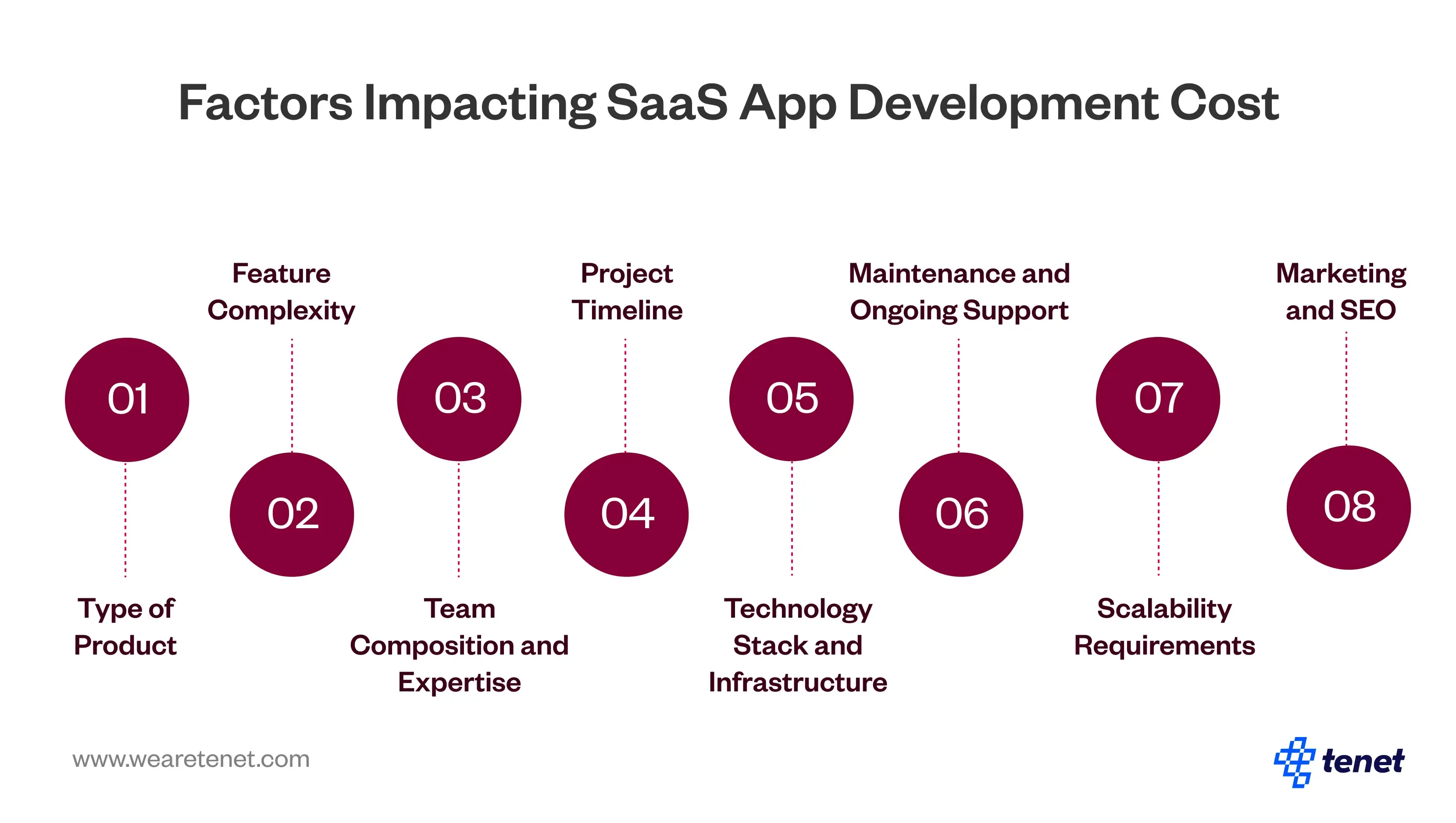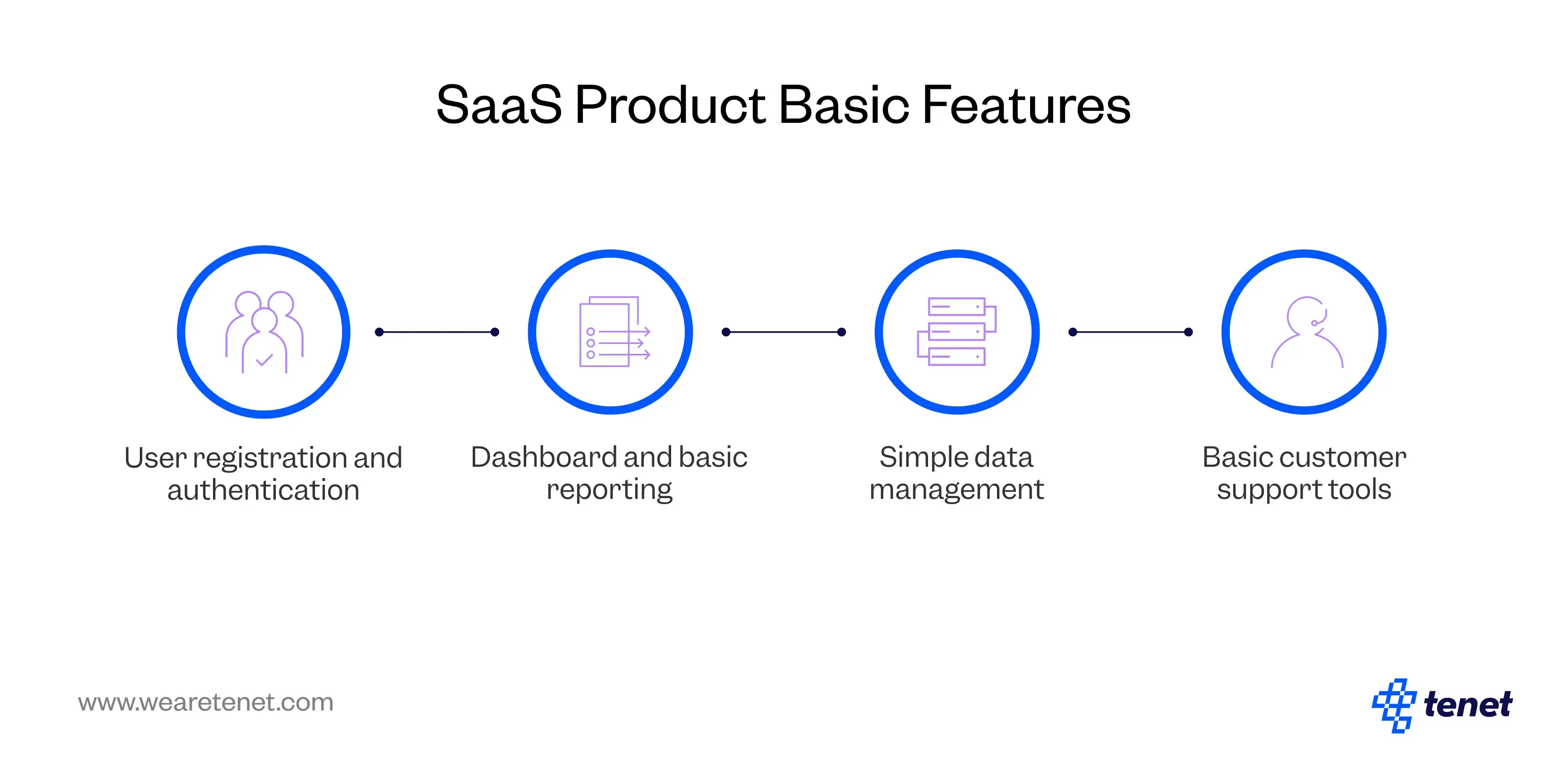 By
By Share
 By
By Share

Budgeting for SaaS app development can feel like solving a complex puzzle. As a UI/UX design company that's helped develop over 450 digital products, we've guided countless founders through this exact challenge.
Recently, we helped a fintech startup reduce their development costs by 40% through strategic design planning and MVP optimization.
In this guide, we'll break down SaaS app or platform development costs based on our experience
The best part?
We will show you how to optimize your SaaS budget using our tried-and-tested framework, and help you avoid the costly pitfalls we've encountered while serving 300+ clients worldwide.
The cost of developing a SaaS application typically ranges from $5,000 for a basic MVP to over $40,000 for an enterprise solution. Small startups can launch with $40,000-50,000 budgets, while mid-sized SaaS platforms usually require $100,000 - $300,000 (one-time cost).
The final cost depends on your feature set, design complexity, and scalability needs.
Explore our SaaS app development services by country:
Based on our hands-on experience in developing multiple SaaS products, we've identified the key factors that influence SaaS development costs.
The key factors influencing SaaS development Costs are:

A SaaS product can have features ranging from basic to complex. Basic features require less time and resources, while advanced functionalities increase complexity and expenses. The development of basic features requires shorter development time and lower cost, and vice versa.
Basic features may include:

On the other hand, advanced features may include:
The features and their complexity can increase the development time and may even require you to hire specialized experts, which can impact the cost of developing the SaaS product.
💡 Pro Tip
Consider launching a Minimum Viable Product (MVP) in the initial release with core features to test the market and gather user feedback.
This approach helps you refine your product based on real user needs while controlling initial development costs.
Based on our experience of designing and developing multiple SaaS products over the years, here is a rough breakdown of the cost of developing a SaaS product based on the scope and complexity of features:
Your choice of technology stack—including programming languages, tools, frameworks, and cloud platforms—significantly affects development costs.:
Programming languages and frameworks are key components of SaaS development, impacting parameters such as development speed, performance, scalability, and maintenance. Here is a breakup of how programming language can impact SaaS Development:
Selecting the right cloud platform is essential for scalability, performance, security, and cost-effectiveness. Choosing the correct cloud platform simplifies the process of developing, deploying, and managing SaaS applications while also assuring high availability, flexibility, and compliance.
Here is a breakup of how cloud platforms and infrastructure can impact the SaaS development:
Did you know? 🤔🤔
More than 88% of SaaS users will never return to a website after having a bad user experience. At the same time, a well-designed and executed UX can boost conversion rates by up to 400%.
This is a clear indication that optimal User Interface (UI) and User Experience (UX) designs are critical for attracting and retaining users. A well-designed interface enhances usability and satisfaction, directly impacting conversion rates and customer loyalty.
Here is a table summarising how UI/UX design impacts the cost of SaaS Development:
When building a SaaS product, it is important to decide if 3rd party integrations are required for the optimal functioning of the product, as this can impact the overall cost of the development.
Third-party APIs can enhance functionalities and save development time as they allow developers to swiftly implement features without the need to build them from scratch. Some important considerations are:
Development Time Savings: APIs allow for rapid implementation of features without building them from scratch.
Expanded Feature Set: Integration can differentiate your product, help meet market demand, and increase user acquisition and retention.
Complexity Management: Multiple integrations can complicate the architecture, requiring more development and maintenance efforts.
Ongoing fees and increased complexity can raise development and maintenance expenses while leveraging existing solutions, reduce initial development time, and make it more cost-effective if managed properly.
Your SaaS project's success depends not just on spending money—but on hiring the right team. A skilled development team can help you build faster, avoid mistakes, and improve ROI.
Choosing the right mix of senior and junior developers is key. Senior developers charge more but work faster and make fewer errors. Junior developers cost less but may take longer and need more support.
You can also choose teams based on location:
Team location affects hourly rates. For example, developers in India charge $15–30/hour, while U.S. developers may charge $90–150/hour.
The geographic location of the development team can also influence the development cost, as the hourly wages can vary across countries. It is as follows:
Explore our other relevant services
Testing and QA make sure your SaaS product works well, stays secure, and offers a smooth user experience. Skipping this step can lead to costly errors later.
Cost Range:
$5,000 to $20,000, depending on your app’s complexity.
Types of Testing:
💡 Why Testing Matters:
Once your SaaS product is live, regular maintenance keeps it secure, updated, and user-friendly. It's not optional—it’s part of long-term success.
Key Benefits of Maintenance:
🚀 Bonus:
User feedback during maintenance helps your team improve features and stay ahead of market trends.
While maintenance adds to your operating costs, it reduces churn, increases satisfaction, and strengthens your brand.
Before hiring a developer or agency, it's important to understand the pricing models used in SaaS development. Each model fits different project types, goals, and budgets.
Here’s a breakdown of the three most common options:
Best for: Clear, well-defined projects with fixed requirements.
How it works:
You agree on a fixed price before the project starts. This price is based on your goals, features, timeline, and deliverables. The agency focuses on completing the project, not tracking hours.
Pros:
Cons:
Typical Cost:
💰 $10,000 to $100,000+
Best for: Ongoing work, flexible projects, or when scope may change.
How it works:
You pay for the actual hours spent on the project. The cost depends on the hourly rate and total hours worked.
Pros:
Cons:
Typical Cost:
💰 $25 to $150 per hour
Best for: High-impact projects with strong ROI potential.
How it works:
The agency sets a price based on the value their solution brings to your business—not just hours or features. If your SaaS product will generate major revenue or user growth, this model aligns pricing with that impact.
Pros:
Cons:
Typical Cost:
💰 $25,000 to $150,000+
To calculate the total estimated cost for your next SaaS development project, you can use the following formula:
Total Estimated Cost = Development Hours*Hourly Rate + Third-Party Integration Costs + Maintenance and Support Costs + Marketing Cost + Miscellaneous Costs
Tenet stands out in the market - because when you hire us, you will be working with a team that has delivered more than 450 solutions, creating an impact on over 20M+ across 15+ countries.
Our clients choose us over our competitors because of our deep understanding of the work and the project ownership we bring to the table. We’re not the cheapest in the market, but what we do is ensure that you reach where you wish to.
We ensure that we don’t just deliver what you want but also what your brand needs. You need experts to guide you, and we ensure that we bring the best of everything to your project. All you have to do is bring your idea, explain the vision, and leave the rest to us.
Still unsure? Take a peek at how we helped our client. To see our past work, check out our portfolio of SaaS development projects.
Contact our expert developers and learn how we can help you in SaaS app development.
SaaS development in 2025 starts at $5,000 using no-code tools and can reach up to $40,000 for more advanced builds. No-code platforms like Bubble and Glide lower costs and speed up launches, but limit custom features and scalability. Custom-coded apps offer full control but require higher budgets and longer timelines.
Key factors impacting the cost of developing a SaaS platform include feature complexity, UI/UX design level, technology stack, third-party integrations, developer location, and testing requirements. Advanced features like real-time data processing or AI raise costs, while MVP launches help control them early on.
To build a SaaS product from scratch, expect to invest anywhere from $20,000 to $300,000+, depending on whether it’s a micro, small, or medium-scale project. For large enterprise systems with complex architecture, the price can exceed $1 million. The pricing model (fixed, hourly, or value-based) also affects the total spend.
SaaS product development pricing follows three primary models: project-based (fixed pricing), hourly pricing, and value-based pricing. Fixed models are ideal for defined scopes, hourly for evolving needs, and value-based for ROI-driven outcomes. Rates can vary from $25/hour to $150/hour, or $10,000 to $150,000+ per project.
Post-launch SaaS expenses include maintenance, cloud hosting, customer support, security monitoring, SEO, and feature upgrades. These recurring costs are essential for reducing churn, maintaining product relevance, and staying compliant with regulations like GDPR or HIPAA.
SaaS software development cost changes significantly based on the team’s location. For example, developers in the US charge $90–$150/hour, while in India, senior developers may charge only $30–$50/hour. Choosing offshore or nearshore teams helps optimize budgets without compromising quality.
Custom SaaS development cost varies based on unique requirements, but typical budgets range from $50,000 to $300,000+. Costs increase with integrations, branding, performance needs, and security features. Tailored UX/UI designs and market-specific optimizations also raise the final cost.
A complete SaaS cost breakdown includes:
This comprehensive approach helps accurately estimate the total cost to build and scale a SaaS platform.
A basic SaaS application or MVP typically takes 3–6 months to develop. More advanced platforms with complex features may require 9–12 months. Timeframes depend on feature sets, tech stack, and development workflow efficiency.
The best SaaS pricing model for startups often combines fixed project pricing for MVPs with value-based pricing as the product matures. This hybrid approach aligns development costs with business value while managing risks and maintaining flexibility during early-stage growth.

Shantanu Pandey is a UI/UX design, branding, and growth marketing expert. As the Founder & CEO of Tenet, he helps global brands create amazing digital experiences.
Expertise Delivered Straight to Your Inbox
Expertise Delivered Straight to Your Inbox

We’d love to hear about your brand, your visions, current challenges, even if you’re not sure what your next step is.
Let’s talk